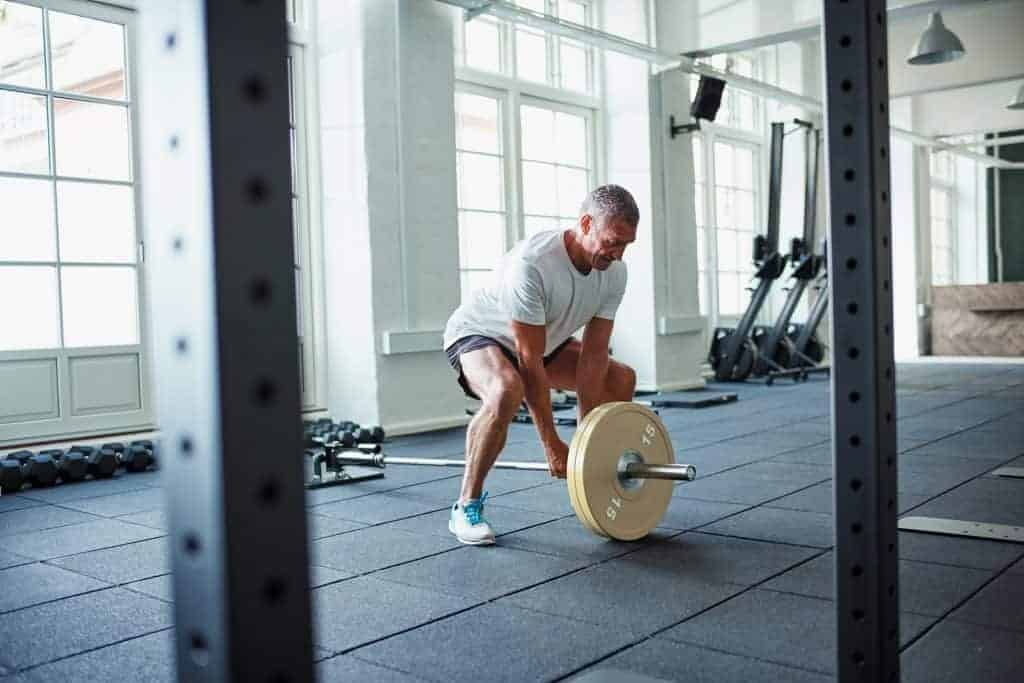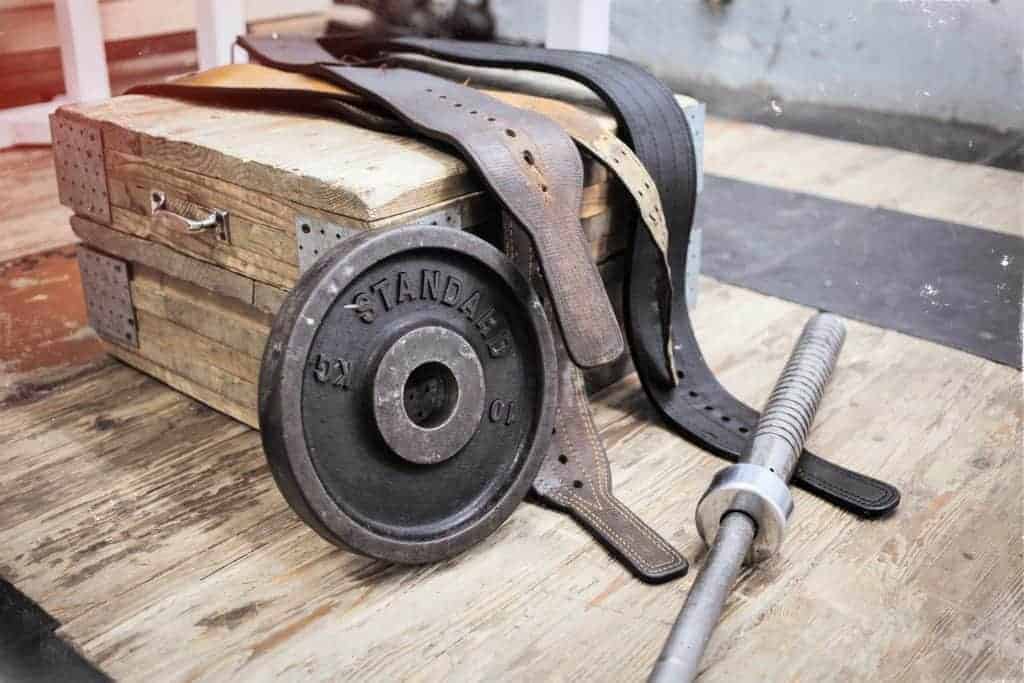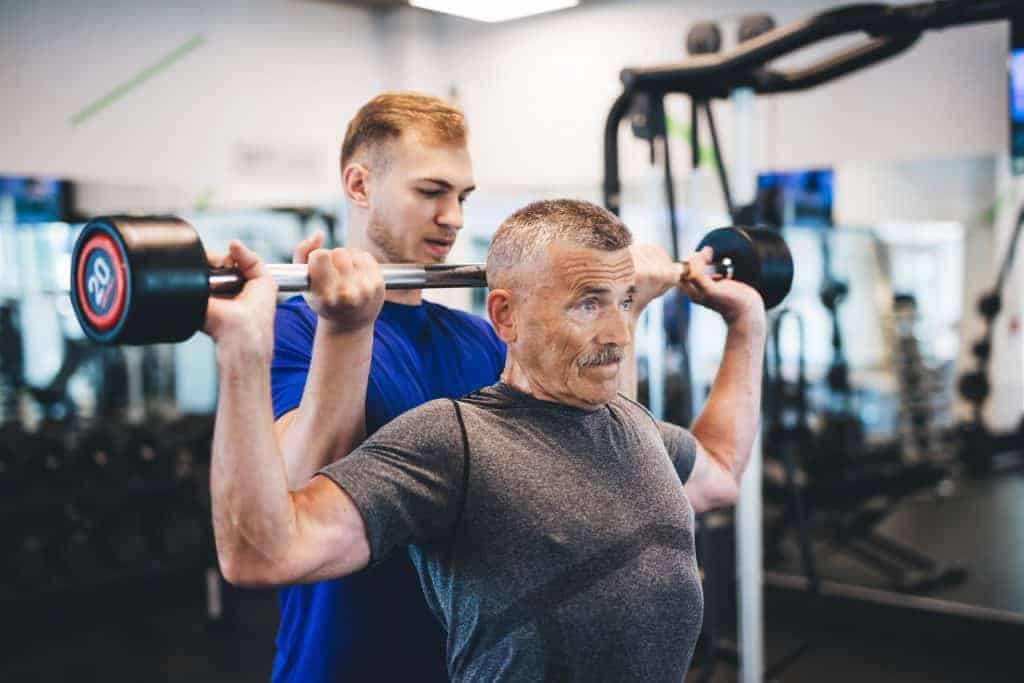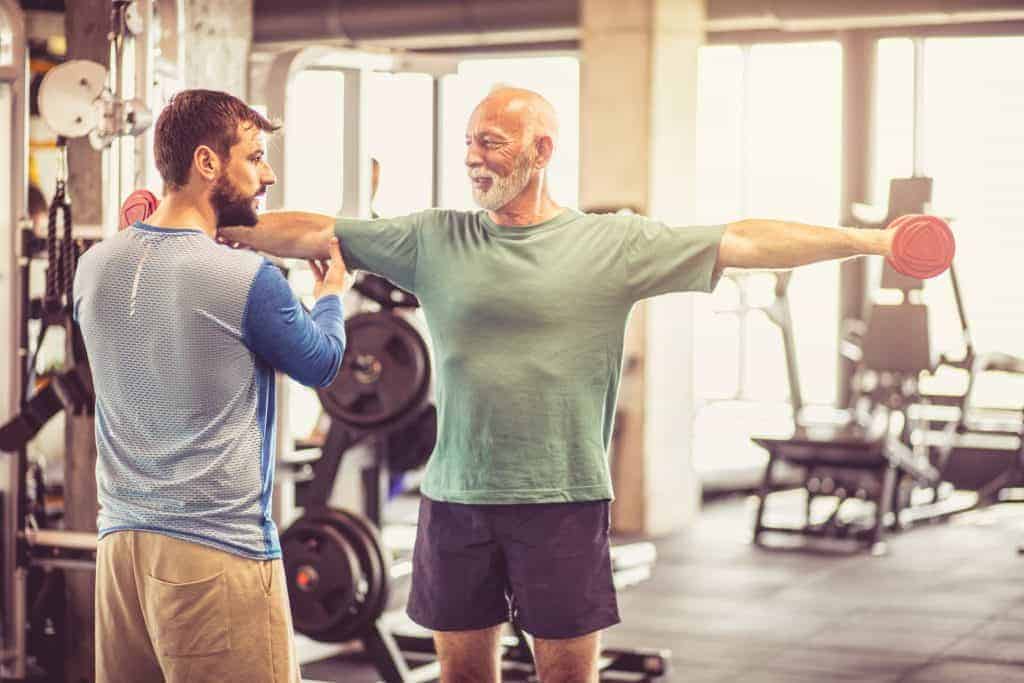This article is evidence-based and verified by Blake Conner, Certified Strength and Conditioning Specialist.
You may initially read this title and think, oh no way! However, powerlifting is very beneficial for seniors. As you age, it is believed that you need to be doing less. This is far from the truth!
As we age, we may lose it if we aren’t using it. This can be in our mobility, flexibility, strength, muscle mass, and sense of balance. However, if we safely take care of our bodies, we can live a long and beautiful life.

In this post, we'll cover:
What Is Powerlifting?
Now, you may or may not have heard of this sport. It is super simple. THREE main lifts are performed before a judge to see who can lift the most weight. The lifts are the back squat, bench press, and deadlift. There are age groups and weight classes that help break down the competition evenly. All three movements have specific points of performance that must be completed to be a successful attempt.
That’s it!
The sport of powerlifting doesn’t always mean that you have to compete either. Many people of all ages practice powerlifting to stay healthy. Many see it as a way of creating a strong mind and body. There is a certain level of grind that comes from this form of sport.
Can You Do It As A Senior?
There will always be people who say that you need to be using light weights as you age. However, there are plenty of studies showing that resistance training does help maintain your muscle mass and bone density as you age . You can side-by-side compare someone who has been lifting weights next to someone who hasn’t, and their bones will be COMPLETELY different.
. You can side-by-side compare someone who has been lifting weights next to someone who hasn’t, and their bones will be COMPLETELY different.
So yes! You can do powerlifting as a senior. There are even age classes that are specifically for seniors. A lifter named Rudy Kadlub is the co-owner of a strength equipment company. He can squat 430lbs, he can deadlift 507lbs, and he can bench 292lbs. How old is he? 70 years old!
He’s exceptionally healthy and remains very active, even in his senior years.
This goes to show that powerlifting as a senior is highly beneficial.
The Lifts
There are only three lifts, and they seem very simple. Pick stuff up, put it down, squat it, or press it. However, a lot goes into each one, especially when you start to get into heavier numbers.
The Squat
The squat is such as foundational movement. Even if you aren’t doing it for powerlifting, you should still include it. As babies, we were pros at this. Watching a baby, he can sit into a perfect squat with no problem. As we age, we lose this ability because we sit while driving or at work.
So, we need to make sure we are doing this right. We need to make sure that we have the bar in the proper placement for the back squat. There are two options here. You can use a high bar placement, or you can use a low bar placement.
The high bar is placed on top of the trapezius muscles. If you think about pinching your shoulder blades together, you’ll create a slight shelf of muscle for the bar to sit on. The sweet spot is below the “boney” protrusion where the neck and back meet.
The high bar differs because it will use a little more of your quads (the front of the leg) versus the hamstrings (on the back). You will also need to remain more upright in your squat. This is all dependent on how mobile you are, as well as your body type.
The low bar squat rests on your “rear deltoids.” These are the muscles on the back of your shoulders. As you do the same pinching of the shoulder blades, you will create a shelf for the bar to rest on. This position is not comfortable for everyone right away.
It does take some getting used to. With the bar being lower on the back, it allows you to lean over more. This creates the opportunity for the hamstrings and glutes, the largest muscles in the body, to kick on. Often, people using the low bar squat can squat more this way. Again, this all depends on your mobility and body shape.
Once you have the bar placed correctly, you need to initiate your squat. This is done by first setting your feet. Make sure that you have them around shoulder-width apart. From here, you will want to point your toes outwards slightly! Drive your heels, big toe, and pinky toe into the ground. From here, imagine screwing your feet into the ground in an outward manner.
This sets your feet and activates all of that good stuff in your legs. Now, we initiate by sending the hips back. Imagine that you are trying to carry groceries in from the car, and you need to use your butt to close the door. Next, we break at the knees and drop down. Maintain tension in your whole body. At no point do we want to get loose.
As you descend, you want to go just slightly below PARALLEL. This means that your hips just barely break below the knees. Immediately drive out of the bottom and stand up. Imagine that you are splitting the floor apart with your legs as you stand. Congratulations, you’ve done a back squat.
Again, the bar’s position is going to be vital for you, so play around with it until you find what is most comfortable for you.
Deadlift
This is a move that most think cannot be made as a senior. WRONG. This is a very foundational movement, just as the squat was. We bend over to pick things up from the ground daily. Often, we do it the wrong way and put bad pressure on the back. When you practice the deadlift, you learn the proper way to do this action.
Set up is one of the most important keys to this movement. You want to approach the bar and have your feet at about hip-width apart. If you have laces on your shoes, you are going to get close enough to where the barbell is directly over the top of those laces. This is the middle of the foot and where we want most of the power to come from.
From here, you are going to shrug your shoulders up, and back, and down. Imagine a piece of paper between your armpits and keep your arms tight enough to keep it there. Arms should be completely locked out. This is going to set up the upper back to stay rigid.
We are going to hinge down. Meaning, get a soft break in the knees, send your hips back, and bring your chest over. From here, you can grab the bar, all the while maintaining that same back stiffness. Pull some slack out of the bar and squeeze the bar very tightly.
From here, we can begin the movement. You will imagine that you are ripping the floor down the middle. This activates the hips. As you do so, you are thinking of bringing your hips forward while standing up. The hips and the chest should both rise at the same time.
At no point should your hips come up and your chest stays down. Keep the bar as close to your body as you can! Think of shaving your legs with the bar. Once you’ve reached the top, you can take the bar back to the ground by reversing that motion. You just did a deadlift!
Now, if you are doing this in a judged competition, you will have to lock all the way out. From here, you have to completely hold onto the bar as you take it to the ground. If you drop it from the top, the judge will not count it. He will be giving your commands the entire time!
Bench Press
This is a movement that you may be all too familiar with. Everyone loves to do the bench press. It seems to be the only number that matters most. Regardless, it is a great movement and has some great upper body benefits for seniors.
The setup for this movement is crucial to your success. It is one of the most missed lifts in powerlifting competitions because so much can be missed. As you get on the bench, make sure that you have at least FIVE points of contact.
This will include both feet, butt, shoulders, and head. From here, pinch your shoulder blades together and drive them into the bench. Grab the bar at about a shoulder-width distance (this will vary from lifter to lifter). Make sure that you have a full grip on the bar. We don’t want it to slip out of your hands.
Now that you’re set up, if you are in a competition, you will have someone give you a lift-off. If you are on your own, I highly recommend a spotter. From here, lower the bar all the way down to your chest.
Make sure that your elbows are at a 45-degree angle, as well as that the bar touches right below the chest. You will have to remain in this position in a competitive setting until the judge tells you to PRESS. From there, drive the barbell until your arms are locked. The spotter will then help you rack the weight.
In a competition, this move is the most missed because the judge is watching a lot. There are multiple points of performance. One is that your feet cannot come off of the ground.
Even if you successfully lift it, this will result in a missed lift. Also, your butt cannot come off of the bench. This is a common mistake that is made when struggling to get the weight up.
If all of these are done correctly, it will be judged as a good lift at the judge’s discrepancy.
Accessory Work And How To Remain Injury Free

There is a risk of injury with weightlifting. Powerlifting especially. However, if done correctly, it is perfectly safe and beneficial. I want to cover some ways in which you can help reduce this risk.
As you age, there is an assumed risk of injury. This is due to a lack of balance, weakening of bones and joints. The wear and tear of life begin to catch up. This doesn’t have to be the case. If someone is active most of their life, they’ll more than likely be fine. However, this may be new to you. That’s great! You need to keep in mind that you will not be AS resilient as you used to be.
I recommend coming into this journey open-minded and finding a coach. Have a trainer or someone who can help teach you. Make sure that it’s someone who is qualified because you need to be eased into this. You shouldn’t walk into the gym, decide to be a powerlifter, and put the most weight possible on the bar. Start small and work your way up. This is a process, and it deserves the respect it has earned. This will be the most impactful way for you to avoid injury.
Maximizing your recovery is also extremely important. Some people go wrong with the “go hard or go home” ideology. This doesn’t allow for recovery to take place. We are putting a ton of stress on the body with this type of training.
At an old age, you aren’t going to recover as fast. That’s just the facts. So, this needs to be considered as you travel down this powerlifting path. Start with around THREE days of training. Make sure that you are taking charge of your nutrition and sleep. As we become “overtrained,” we become more susceptible to injuries. Want to know the best way to keep powerlifting as a senior? Don’t get hurt.
Accessory work refers to the extra work you do besides your main lifts. Your training should include something centered around squat, bench, and deadlift. The body can move in other ways as well. Accessory work can include movements that highlight weaker areas of your body or mobility. I’ll be providing some examples.
This accessory work may address nagging injuries or help you balance out the body’s strength. Again, this is a great way to avoid injury as a senior doing powerlifting.
Powerlifting Equipment

We’ve all seen them before. The guy or girl at the gym is decked out in all of the workout gear. Some of this has a purpose, some not. Here is a description of the equipment that will help you as you pursue powerlifting in this age group.
Belts are very useful. It will help to stabilize your spine. This is done by increasing intra-abdominal pressure or the amount of air compressed in your abdomen. This creates a more rigid spine while you do any of the movements. It is common to see individuals using it the wrong way, however. It tends to be placed close to the navel to “be on the back.” However, the belt needs to be placed right below the rib cage.
This is where the diaphragm is, and it allows for the most pressure to be created. Breathe into the belly and force the air into the belt. This does, however, use what is referred to as the Valsalva Maneuver, or create that pressure. It can increase your blood pressure, so be cautious when using this technique if you have issues with your blood pressure .
.
If you have wrist issues, a great solution is a wrist wrap. This is a band with some elasticity that you wrap and stabilize the wrist with. It is great for any movement that involves pressing. The wraps create stiffness in the wrist, therefore minimizing the risk for injury.
As we age, the knees can lose some integrity. One way to help support them is with some knee sleeves. These are made from the same material as wet suits. The benefit comes from the compression they provide, but also from the heat. As we get warmer, the body moves better. Having something on the body that will help get them warm is extremely beneficial and keeps them safe!
Equipment should be used because it is needed and not used just “because.” We don’t want to rely on the equipment to make us good lifters. We want the equipment to assist us in being the best lifter we can be.
Powerlifting Routines For Older Lifters

I will provide some sample powerlifting workouts that will include some accessory work within them. We will assume that a person using these has established some baseline of squatting, benching, and deadlifting.
Workout #1 – Squat Day
- General Warm-Up
- Stretches hitting the proper muscles. Light cardio to get the heart rate up. Bodyweight squats to practice the movement pattern.
- Back Squat
- 5 sets of 6 reps @ a moderate to heavyweight
- Romanian Deadlift
- 5 sets of 10 reps @ a moderate weight
- Back Rack Reverse Lunges
- 4 sets of 8 on each leg @ a lightweight
- Goblet Box Squats
- 3 sets of 8 reps @ a moderate weight
- Ab Roll Outs
- 5 sets of 12 reps
Workout #2 – Bench Day
- Warm-Up
- Band pull-a-parts 5×20 reps
- Pull-up bar hangs 5x20s hold
- Push-up 5×8 reps
- Doorway stretch 5x20s hold
- Barbell Bench Press
- 5 sets of 6 reps @ a moderate to heavyweight
- 1-Arm DB Bench Press
- 5 sets of 8 reps on each arm @ a moderate weight
- Lying DB Pull Over
- 5 sets of 12 reps @ a lightweight
- Lying Tricep Extension
- 5 sets of 15 reps @ a lightweight
Workout #3 – Deadlift Day
- Warm-Up
- Birddogs 5×20 total
- Deadbug holds 5x20s hold
- Bodyweight Goodmornings 5×20 reps
- Negative pull-ups 5×5 reps
- Empty bar deadlifts 5×20 reps
- Barbell Deadlift
- 5 sets of 5 reps @ a moderate to heavyweight
- Bent Over DB Rows
- 5 sets of 8 rep each arm @ moderate weight
- Strict Pull-Ups
- 5 sets of max reps
- Barbell Glute Bridges
- 5 sets of 10 reps @ light to moderate weight
The workouts above are explicitly designed around the main lifts that you will be doing as a powerlifter. They are movements that can be done even into the later stages of life.
So long as they are approached safely and with purpose, they are great! The accessory work and warmups are there to ensure that injury risk stays as low as possible; this way, you can continue to pursue strength training.
Conclusion

Powerlifting is an amazing sport. It is also even cooler for people in the later stages of their life. It creates something to compete for but is also a great way to stay fit. It can help maintain the integrity of bones and tendons and improve strength and balance.
As always, weightlifting should be approached with proper care. You should seek a coach or trainer to help show you the proper way to do the movements. The squat, bench, and deadlift are great, but they involve a ton of technique.
Make sure to utilize accessory work as you go through your routine as well; accessory exercises can be done with traditional weights, kettlebells , or even clubbells
, or even clubbells .
.
This will help to mitigate any weak areas or injuries. Proper warmups, particularly with resistance bands , will also be fantastic for avoiding injury!
, will also be fantastic for avoiding injury!
Whether you want to compete as a senior or enjoy a different way to work out, powerlifting is a great fit!
Benefits Of Nordic Walking For Seniors

Blake Conner is a nutritionist who graduated from Mississippi State University. He is also a Certified Strength and Conditioning Specialist through the NSCA and a certified nutrition coach through Precision Nutrition. Blake runs his own remote nutrition coaching business to help people become the best versions of themselves.
References
- https://www.ncbi.nlm.nih.gov/pubmed/30513557

- https://www.ncbi.nlm.nih.gov/pubmed/29052077

- https://www.ncbi.nlm.nih.gov/pubmed/28673759

